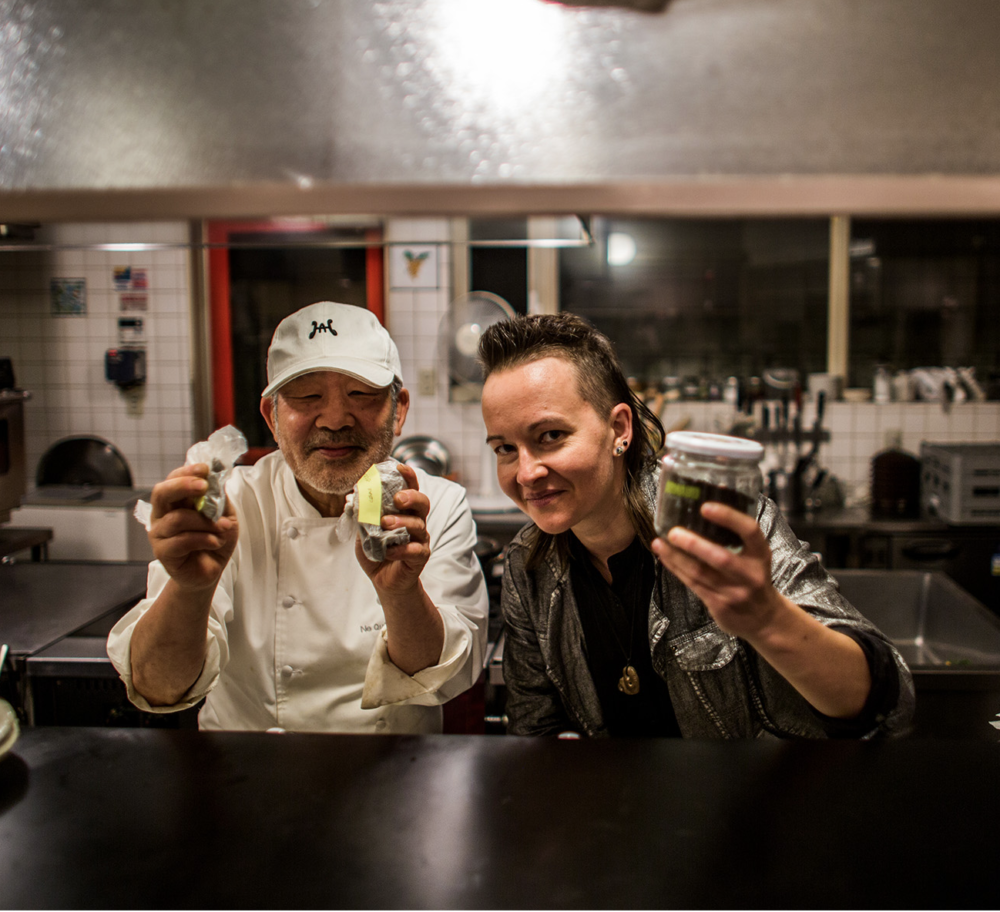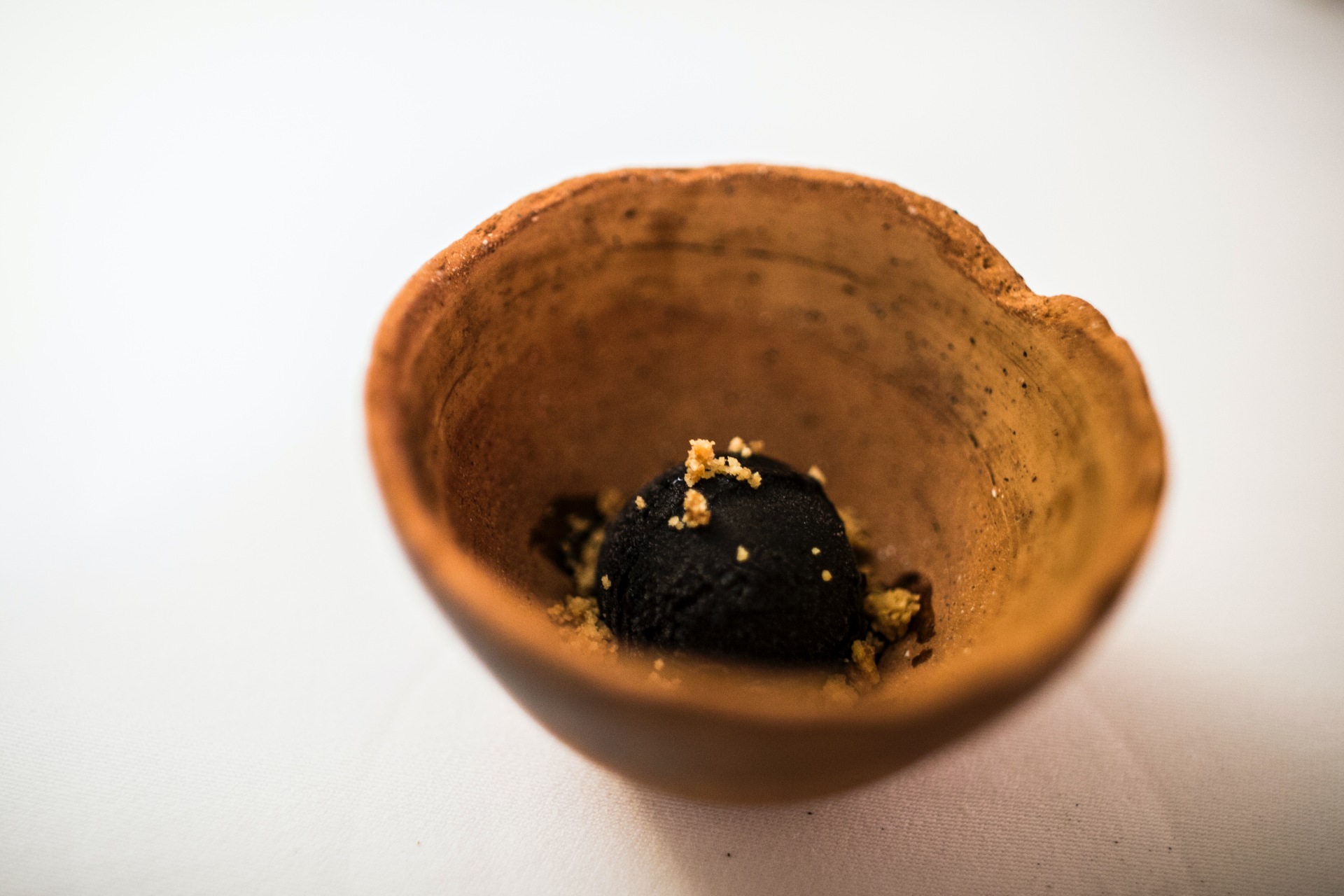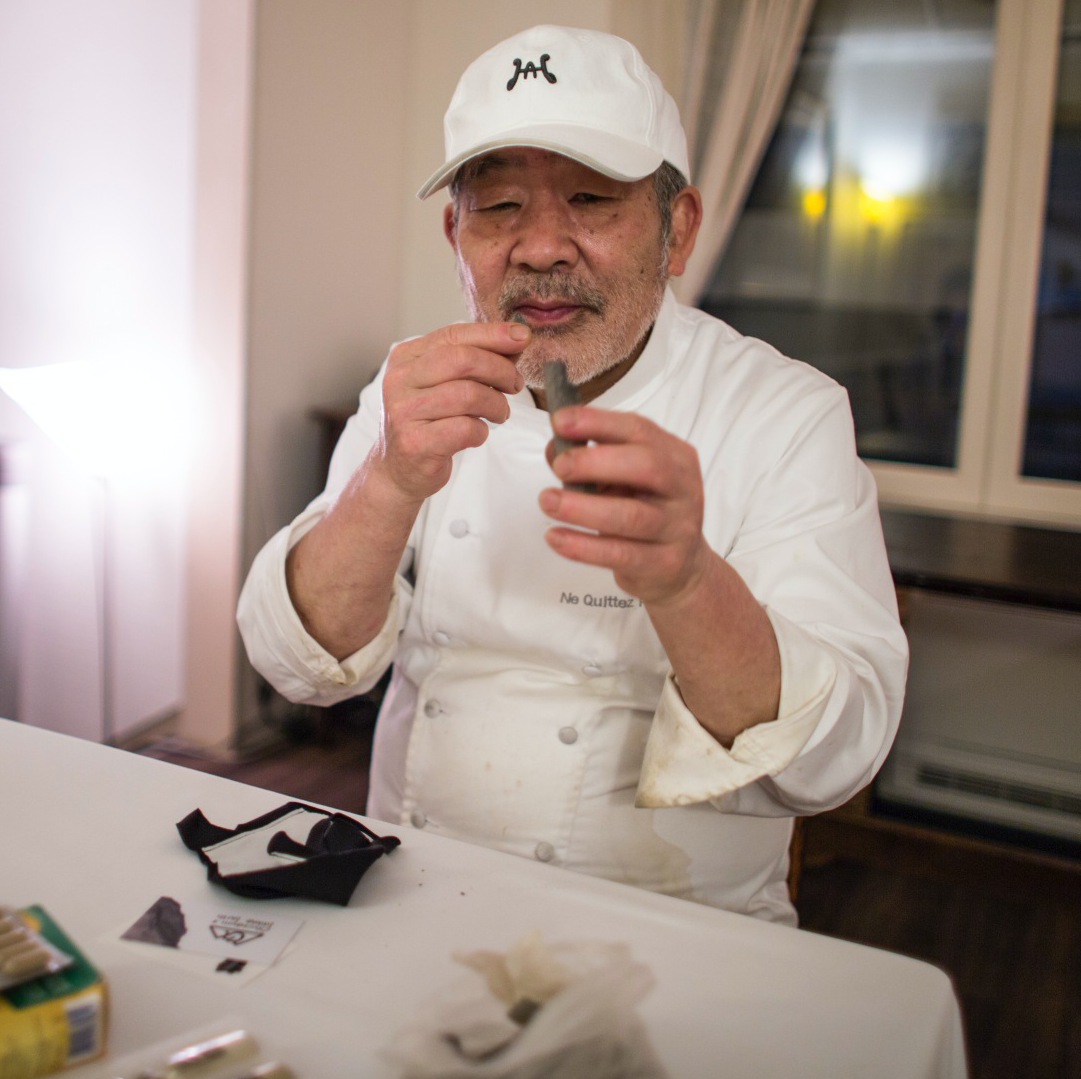A grounding culinary experience: Museum of Edible Earth founder masharu visits soil cuisine restaurant by Toshio Tanabe
For more than 10 years, Ne Quittez Pas has been recognized in media for their highly praised soil-based menu. After thoroughly enjoying Tanabe’s flavorful and earthy cuisine, masharu sat down with the chef himself to talk about the background, challenges and insights behind their respective projects.
The natural craving to eat earth
Tanabe: So, how did you find today’s soil course?
masharu: Wonderful! From the soil soufflé au foie gras to the main dish with rice and typical Japanese tubercles like gobo (edible burdock), everything was delicious. And I liked that some of the courses were presented in unglazed ceramic plates and bowls.
Tanabe: I find that the ceramic helps enhance the earthy taste.
masharu: Definitely! I also noticed the different temperatures, textures and aromas. Some of them reminded me of rain, wood, or even licorice. It has been one of the best moments of my trip to Japan. I have wanted to come to your restaurant since 2013, when I first discovered your soil cuisine while researching earth-cooking practices. I have brought some of my samples for you today. Please try them if you’d like!
Tanabe: Thank you! These are mainly clay right? From Congo, France… They taste good… Why did you start eating and researching earth?
masharu: It all started from my own desires, I just had this urge to eat soil myself. Looking back, I think it may be connected to the fact that I’ve lived in cities for all of my life. Only in my childhood I spent summers in the countryside. Eating earth was an intuitive craving to be more connected with nature, with our planet. Since I started the Museum of Edible Earth project, I feel that I finally live life being true to myself. My work is something I believe in, not something I do just for money or to make a living.

Tanabe: For me, the idea of tasting soil came naturally, too. When I started as a chef, I traveled all around Japan together with an agricultural specialist, searching for the best quality vegetables. He would always talk about the soil, its quality, composition, and how it affects the food that we grow in it. He also told me that it could be eaten. For instance, when you plug out a carrot, it has soil on it, right? If you shake it lightly, the sand comes off, and then you can eat it just like that.
masharu: Did you start using it in your restaurant from the beginning?
Tanabe: No, I first introduced the soil course 10 years ago, when I was asked to present an unusual menu in a TV cooking contest. The idea came to me suddenly: I boiled soil and prepared a sauce with it. Not only did I win the prize, but from the next day, I received daily calls from people from all over the country telling me: “I want to try your dish!”. That was when I learned that there are many who are interested in soil and earth.
What we do to ourselves, what we do to our planet
masharu: I have been investigating earth-eating practices and traditions in many countries, and in most places, people just consume it in its pure form. This is why your soil cuisine is strikingly unique.
I have collaborated with cooks only a few times. Once, I worked together with an artist to produce clay ice cream, but earth is not recognized as a food product in the Netherlands, so we could only label it as an artistic performance and the ice cream could not be sold to the general public. In my earth-tasting workshops, people can taste the soil at their own risk, but it is nothing like a restaurant.
Tanabe: The soil we offer in our restaurant comes from very specific places in Japan and goes through very strict tests. It is also thoroughly heated. We only cook with black and white topsoil extracted from 5 to 10 meters underground in Tochigi prefecture, and just recently started experimenting with human made soil produced by Kanazawa Bio laboratory in Kyushu. The ground in Japan is polluted with pesticides, wastewater, and so on, so it is very hard to find edible soil.

masharu: It makes you question what we are doing to ourselves, and what we are doing to our Earth.
For instance, there is extensive debate and research on whether it is healthy to eat earth, but we can easily buy clearly unhealthy products in any supermarket. Sometimes I feel both self-destruction and planet destruction are very normalized in our societies.
The Museum of Edible Earth makes even more evident the ongoing destruction of the natural environment. For example, the collection includes many Ukrainian samples from extraction places that have been terribly polluted because of the war. It won’t be possible in our lifetime to get them anymore, at least not for human consumption. We take the Earth’s immutability for granted, but it changes faster than we might think, and us humans have a significant impact on our environment.
A citizen of the world
Tanabe: I agree. And I think that what and how we eat definitely shapes our relationship to the environment. Even if we tend to forget it, humans are natural beings, and the act of eating connects us to the natural world.
masharu: Eating earth evokes in me this feeling of being grounded. It makes me feel connected to different places so that I become a citizen of the world. When I talk to people who eat earth, most mention traditions, cravings… But some also experience transcendental experiences, like dreams and memories. As humans, our roots link back to the African continent. We have changed since then, but the whole process is ingrained in us. The fact that I was born in Russia or now live in the Netherlands is just the last bit of the whole story, the most superficial layer. In the end, our roots, our planet, everything is shared.
This is also why it is so important for the Museum to be mobile. It is a collection of samples from all over the world, so I find it’s not right for it to stay in one place. The element of exchange is also essential in this project, which is why I have brought samples for you today, and would like to ask for some of your soil in exchange!

Tanabe: I will gladly give you some of my soil, of course! I’m glad it will become part of your collection. It means many different people will get to know about Japan’s soil, and my restaurant.
masharu: Yes. The mobility of the Museum allows it to reach out to literally any type of visitor. It goes out to the people to meet them! Part of the target audience is the people living in the cities, people making the decisions who sometimes don’t touch ground a lot, but in reality, it is open to everybody. Everybody is important because we are human and we are held by the planet earth. Earth is something that should not be exclusive.
Tanabe: No matter what culture, nationality or background, we all came from the Earth in the end, just like the rest of living beings. Whether we eat it or not, it is a fact that we cannot live without it.
masharu: Yes. We are walking this Earth, we live on this Earth, we will go back to Earth.
https://fabcafe.com/magazine/global/masharu_visits_Ne_Quittez_Pas
FabCafe Global Editorial Team

